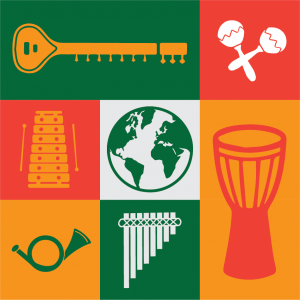Introduction

Project Overview
Welcome to Beyond the Classroom: World Music from the Musician’s Point of View. In the summer of 2021, we met with, and video recorded soloists and small groups of musicians who are experts in each of the ten musical traditions found in this resource. The videos make up the bulk of this project.
The primary goal of this project is to make a resource available to teachers and students for learning about the ideas, sounds, and behaviors of various musics of the world based on the understandings and practices of the musicians themselves. In this spirit, we let the musicians take the lead during each of the video sessions. Our role was not as subject experts, but rather as facilitators because the musicians are the subject experts. They are the teachers. During the sessions, we jumped in with some questions when we heard something we didn’t understand, or that we thought the students wouldn’t understand, or that we thought would be of further interest. Other than these interruptions, the musicians were in charge.
A second goal is to include diverse voices as well as diverse musics. The musicians represent a variety of ethnicities, cultures, and musical traditions: Native Canadian pow wow, traditional Ottawa-valley fiddle styles, Cuban percussion, urban Cuban musical styles, mbira music of Zimbabwe, Carnatic percussion, Hindustani music, Iranian classical music, Balinese gamelan and West Asian melodic practice (mostly Turkish and Arab music). As well, there is a contribution from women who address issues of gender in their musical tradition.
A third goal is to provide some ideas for activities and assessments based on the videos. We suggest participatory activities that will engage students while reinforcing aural, intellectual, and embodied knowledge and skills. We provide ways for students to learn some of the underlying performative principles of the music. Our aim is to provide possibilities for how instructors could work with the content. Adapt and build on these ideas as best suits the needs of your group of learners.
Each unit that follows is structured as follows:
- A brief overview of the musical culture.
- A short bio of the musicians.
- A list of terms useful to know before watching the video.
- A summary of the content of the video.
- The video.
- Time cues corresponding to the various topics addressed in the video.
- Suggestions for classroom activities and assessments
The sessions were recorded during the pandemic and had to be done remotely for reasons of safety. As a result, they are more like live performance recordings than studio recordings made in a controlled environment. They are also more akin to fieldwork in ethnomusicology than a classroom presentation because there wasn’t a pre-planned structure for the video recordings. It was the musicians’ culture-based, first-hand knowledge that set the tone, content, and shape of the sessions.
These videos can be used not only for classes in ethnomusicology but also in music survey courses, as interdisciplinary content for studies in history, anthropology, cultural studies, international studies, or any subject where knowledge of expressive culture can be useful in understanding the contemporary world.
As a final thought we leave you with this: we do not claim that our choices and suggestions are exhaustive. You may very well find uses for these videos that we haven’t thought of. We hope you do. But like any good musical composition or improvisation, the outcome is related to the quality of the input. These videos present exceptional, not-easy-to-find-anywhere-else content that you can use to help create exciting learning opportunities for your students.
Dr. Howard Spring
Dr. Ryan Bruce
Guelph and Hamilton 2022
